Abstract
Intracellular recordings were made from hippocampal CA1 pyramidal neurons within brain slices of nictitating membrane conditioned, pseudoconditioned, and naive adult male albino rabbits. All neurons included (26 conditioned, 26 pseudoconditioned, and 28 naive) had stable penetration and at least 60 mV action potential amplitudes. Mean input resistances were approximately equal to 60 mu omega for the three groups. A marked reduction in the afterhyperpolarization (AHP) following an impulse was apparent for conditioned (x = -0.98 mV) as compared to the pseudoconditioned (x = -1.7 mV) and naive (x = -2.0 mV) neurons. The AHP has been attributed previously to activation of a Ca2+-dependent outward K+ current. The distribution of AHP amplitudes for the conditioned group included a new lower range of values for which there was little overlap with the other groups. The conditioning-specific reduction of AHP may be due to reduction of ICa2+-K+ as shown previously for conditioned Hermissenda neurons. This conditioning-induced biophysical alteration of the CA1 pyramidal cell must be stored by mechanisms intrinsic to the hippocampal slice and cannot be explained as a consequence of changes of presynaptic input arising elsewhere in the brain. Our experiments demonstrate the feasibility of analyzing cellular mechanisms of associative learning in mammalian brain with the in vitro brain slice technique.
Full text
PDF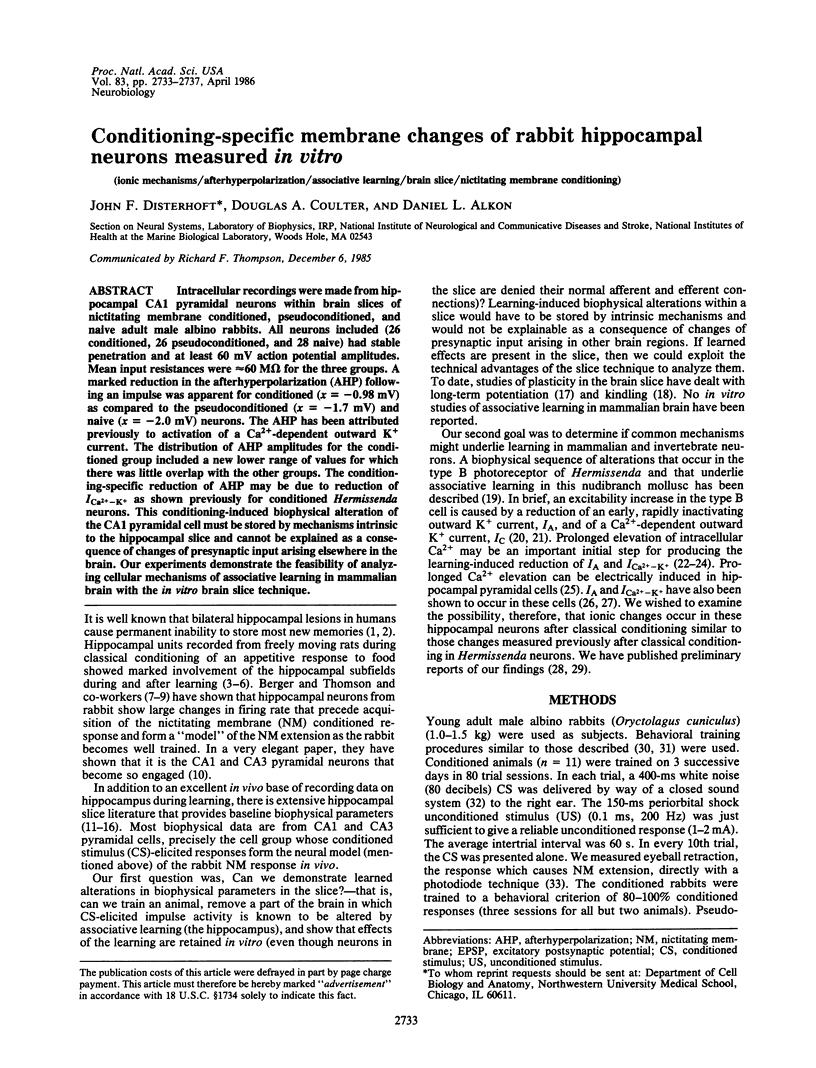
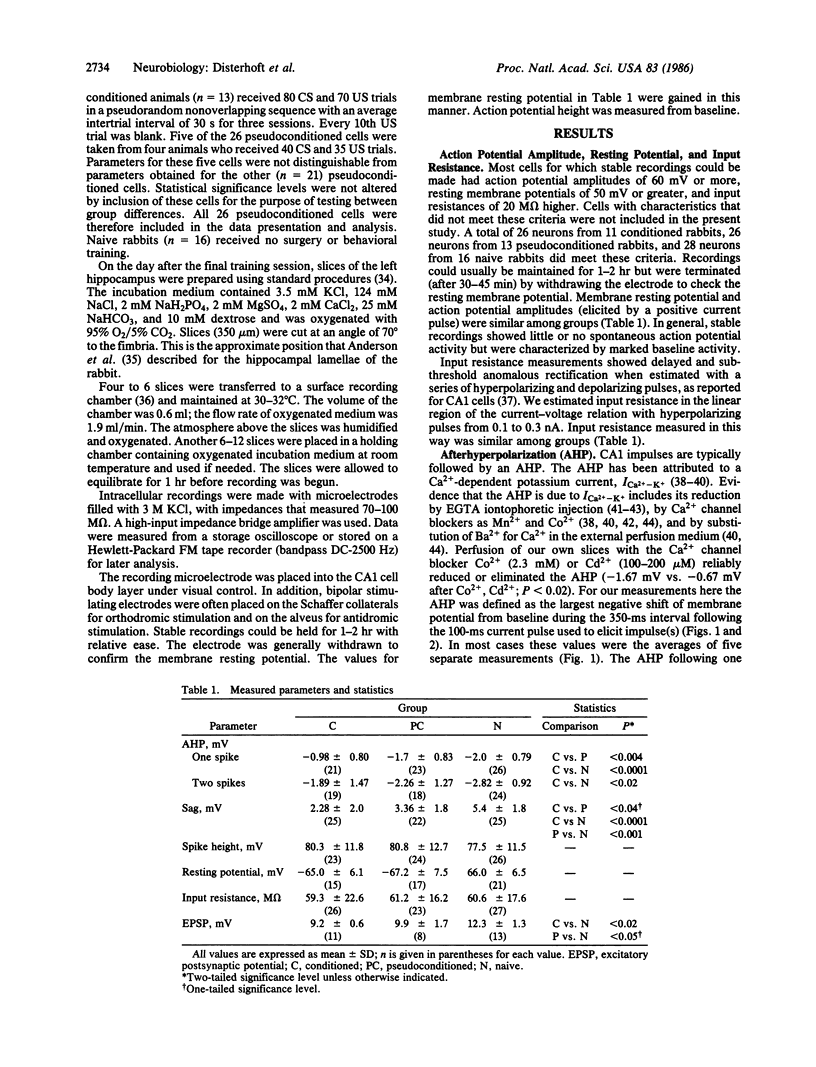
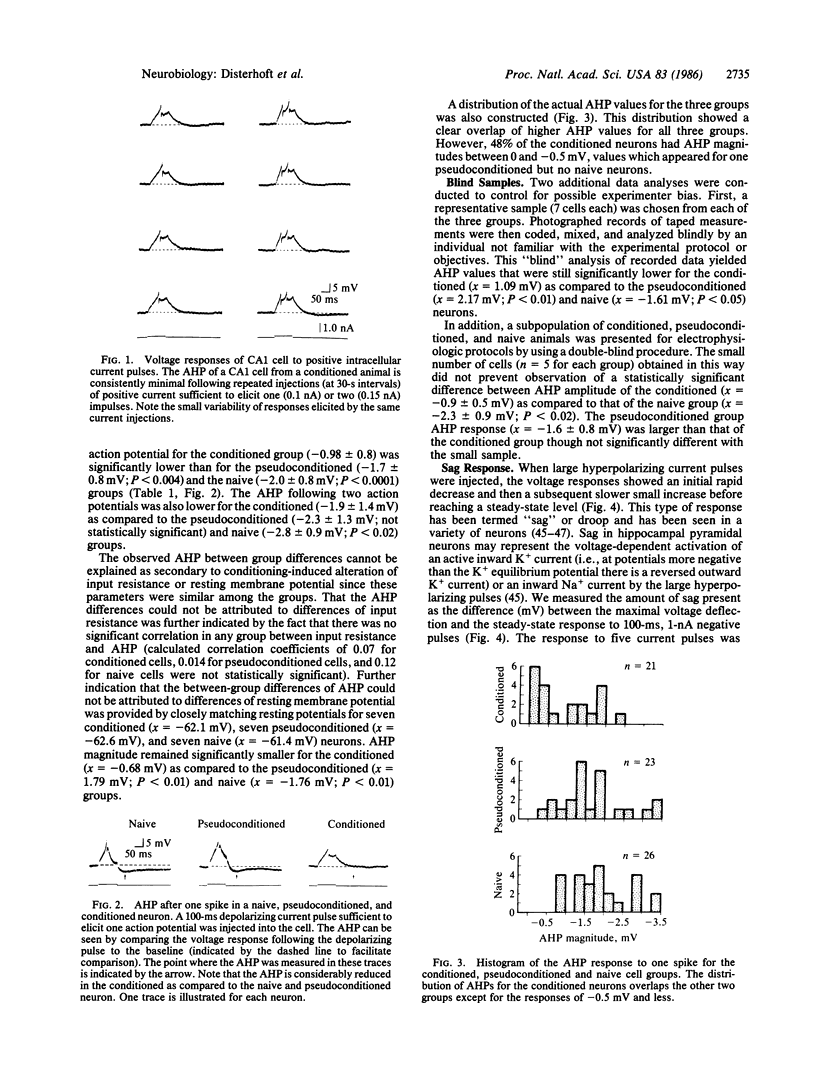
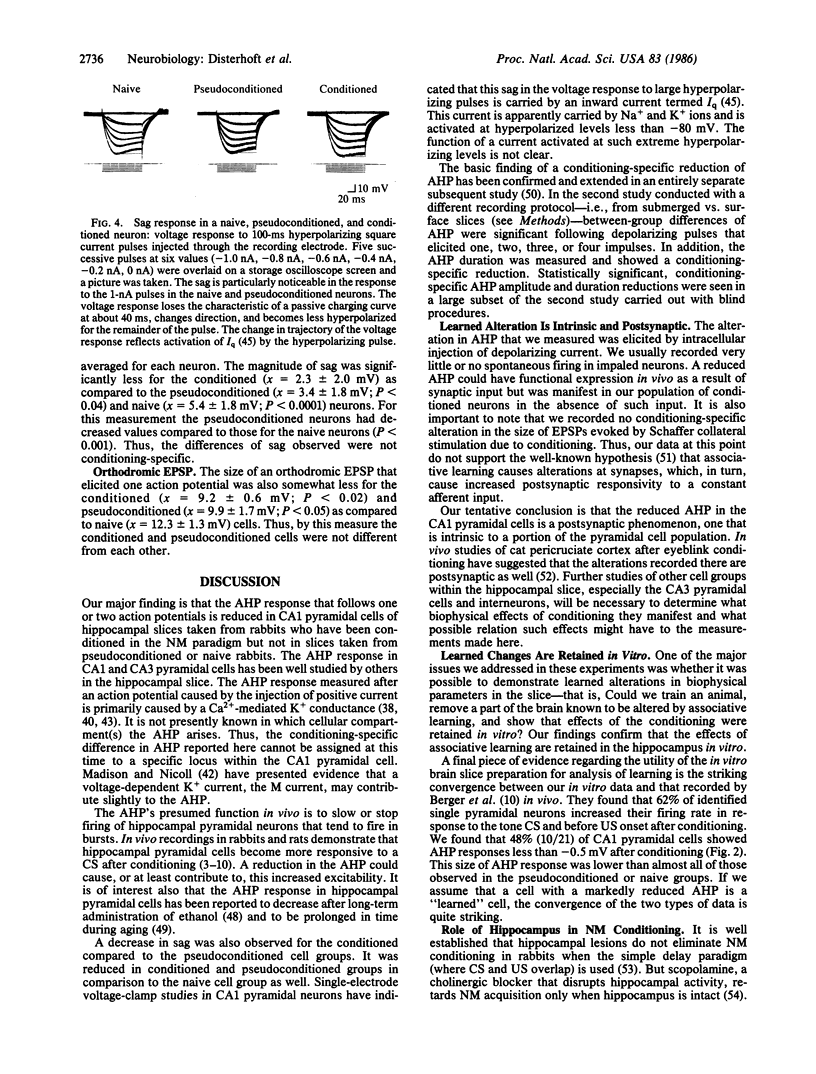
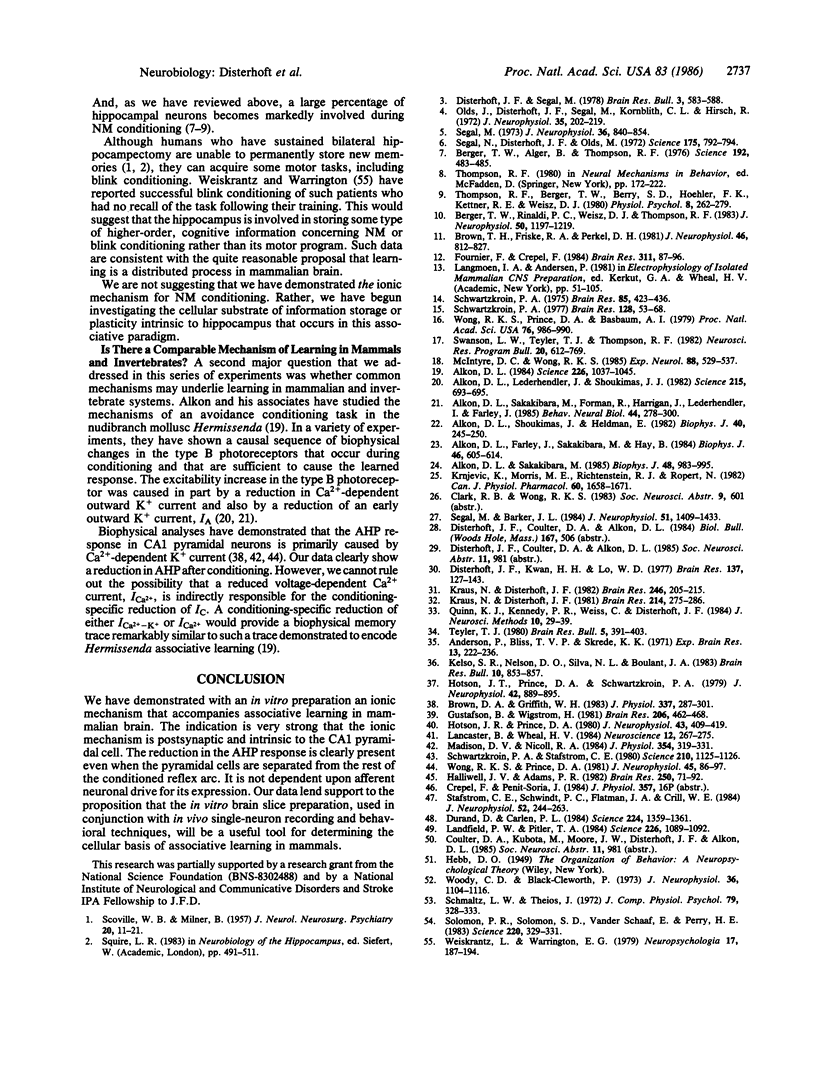
Selected References
These references are in PubMed. This may not be the complete list of references from this article.
- Alkon D. L. Calcium-mediated reduction of ionic currents: a biophysical memory trace. Science. 1984 Nov 30;226(4678):1037–1045. doi: 10.1126/science.6093258. [DOI] [PubMed] [Google Scholar]
- Alkon D. L., Farley J., Sakakibara M., Hay B. Voltage-dependent calcium and calcium-activated potassium currents of a molluscan photoreceptor. Biophys J. 1984 Nov;46(5):605–614. doi: 10.1016/S0006-3495(84)84059-X. [DOI] [PMC free article] [PubMed] [Google Scholar]
- Alkon D. L., Lederhendler I., Shoukimas J. J. Primary changes of membrane currents during retention of associative learning. Science. 1982 Feb 5;215(4533):693–695. doi: 10.1126/science.7058334. [DOI] [PubMed] [Google Scholar]
- Alkon D. L., Sakakibara M. Calcium activates and inactivates a photoreceptor soma potassium current. Biophys J. 1985 Dec;48(6):983–995. doi: 10.1016/S0006-3495(85)83861-3. [DOI] [PMC free article] [PubMed] [Google Scholar]
- Alkon D. L., Sakakibara M., Forman R., Harrigan J., Lederhendler I., Farley J. Reduction of two voltage-dependent K+ currents mediates retention of a learned association. Behav Neural Biol. 1985 Sep;44(2):278–300. doi: 10.1016/s0163-1047(85)90296-1. [DOI] [PubMed] [Google Scholar]
- Alkon D. L., Shoukimas J. J., Heldman E. Calcium-mediated decrease of a voltage-dependent potassium current. Biophys J. 1982 Dec;40(3):245–250. doi: 10.1016/S0006-3495(82)84479-2. [DOI] [PMC free article] [PubMed] [Google Scholar]
- Andersen P., Bliss T. V., Skrede K. K. Lamellar organization of hippocampal pathways. Exp Brain Res. 1971;13(2):222–238. doi: 10.1007/BF00234087. [DOI] [PubMed] [Google Scholar]
- Berger T. W., Alger B., Thompson R. F. Neuronal substrate of classical conditioning in the hippocampus. Science. 1976 Apr 30;192(4238):483–485. doi: 10.1126/science.1257783. [DOI] [PubMed] [Google Scholar]
- Berger T. W., Rinaldi P. C., Weisz D. J., Thompson R. F. Single-unit analysis of different hippocampal cell types during classical conditioning of rabbit nictitating membrane response. J Neurophysiol. 1983 Nov;50(5):1197–1219. doi: 10.1152/jn.1983.50.5.1197. [DOI] [PubMed] [Google Scholar]
- Brown D. A., Griffith W. H. Calcium-activated outward current in voltage-clamped hippocampal neurones of the guinea-pig. J Physiol. 1983 Apr;337:287–301. doi: 10.1113/jphysiol.1983.sp014624. [DOI] [PMC free article] [PubMed] [Google Scholar]
- Brown T. H., Fricke R. A., Perkel D. H. Passive electrical constants in three classes of hippocampal neurons. J Neurophysiol. 1981 Oct;46(4):812–827. doi: 10.1152/jn.1981.46.4.812. [DOI] [PubMed] [Google Scholar]
- Disterhoft J. F., Kwan H. H., Lo W. D. Nictitating membrane conditioning to tone in the immobilized albino rabbit. Brain Res. 1977 Nov 25;137(1):127–143. doi: 10.1016/0006-8993(77)91016-2. [DOI] [PubMed] [Google Scholar]
- Disterhoft J. F., Segal M. Neuron activity in rat hippocampus and motor cortex during discrimination reversal. Brain Res Bull. 1978 Nov-Dec;3(6):583–588. doi: 10.1016/0361-9230(78)90003-5. [DOI] [PubMed] [Google Scholar]
- Durand D., Carlen P. L. Decreased neuronal inhibition in vitro after long-term administration of ethanol. Science. 1984 Jun 22;224(4655):1359–1361. doi: 10.1126/science.6328654. [DOI] [PubMed] [Google Scholar]
- Fournier E., Crepel F. Electrophysiological properties of in vitro hippocampal pyramidal cells from normal and staggerer mutant mice. Brain Res. 1984 Oct 8;311(1):87–96. doi: 10.1016/0006-8993(84)91401-x. [DOI] [PubMed] [Google Scholar]
- Gustafsson B., Wigström H. Evidence for two types of afterhyperpolarization in CA1 pyramidal cells in the hippocampus. Brain Res. 1981 Feb 16;206(2):462–468. doi: 10.1016/0006-8993(81)90548-5. [DOI] [PubMed] [Google Scholar]
- Halliwell J. V., Adams P. R. Voltage-clamp analysis of muscarinic excitation in hippocampal neurons. Brain Res. 1982 Oct 28;250(1):71–92. doi: 10.1016/0006-8993(82)90954-4. [DOI] [PubMed] [Google Scholar]
- Hotson J. R., Prince D. A. A calcium-activated hyperpolarization follows repetitive firing in hippocampal neurons. J Neurophysiol. 1980 Feb;43(2):409–419. doi: 10.1152/jn.1980.43.2.409. [DOI] [PubMed] [Google Scholar]
- Hotson J. R., Prince D. A., Schwartzkroin P. A. Anomalous inward rectification in hippocampal neurons. J Neurophysiol. 1979 May;42(3):889–895. doi: 10.1152/jn.1979.42.3.889. [DOI] [PubMed] [Google Scholar]
- Kelso S. R., Nelson D. O., Silva N. L., Boulant J. A. A slice chamber for intracellular and extracellular recording during continuous perfusion. Brain Res Bull. 1983 Jun;10(6):853–857. doi: 10.1016/0361-9230(83)90219-8. [DOI] [PubMed] [Google Scholar]
- Kraus N., Disterhoft J. F. Location of rabbit auditory cortex and description of single unit activity. Brain Res. 1981 Jun 15;214(2):275–286. doi: 10.1016/0006-8993(81)91194-x. [DOI] [PubMed] [Google Scholar]
- Kraus N., Disterhoft J. F. Response plasticity of single neurons in rabbit auditory association cortex during tone-signalled learning. Brain Res. 1982 Aug 26;246(2):205–215. doi: 10.1016/0006-8993(82)91168-4. [DOI] [PubMed] [Google Scholar]
- Krnjević K., Morris M. E., Reiffenstein R. J., Ropert N. Depth distribution and mechanism of changes in extracellular K+ and Ca2+ concentrations in the hippocampus. Can J Physiol Pharmacol. 1982 Dec;60(12):1658–1671. doi: 10.1139/y82-244. [DOI] [PubMed] [Google Scholar]
- Lancaster B., Wheal H. V. The synaptically evoked late hyperpolarisation in hippocampal CA1 pyramidal cells is resistant to intracellular EGTA. Neuroscience. 1984 May;12(1):267–275. doi: 10.1016/0306-4522(84)90152-0. [DOI] [PubMed] [Google Scholar]
- Landfield P. W., Pitler T. A. Prolonged Ca2+-dependent afterhyperpolarizations in hippocampal neurons of aged rats. Science. 1984 Nov 30;226(4678):1089–1092. doi: 10.1126/science.6494926. [DOI] [PubMed] [Google Scholar]
- Madison D. V., Nicoll R. A. Control of the repetitive discharge of rat CA 1 pyramidal neurones in vitro. J Physiol. 1984 Sep;354:319–331. doi: 10.1113/jphysiol.1984.sp015378. [DOI] [PMC free article] [PubMed] [Google Scholar]
- McIntyre D. C., Wong R. K. Modification of local neuronal interactions by amygdala kindling examined in vitro. Exp Neurol. 1985 Jun;88(3):529–537. doi: 10.1016/0014-4886(85)90068-8. [DOI] [PubMed] [Google Scholar]
- Olds J., Disterhoft J. F., Segal M., Kornblith C. L., Hirsh R. Learning centers of rat brain mapped by measuring latencies of conditioned unit responses. J Neurophysiol. 1972 Mar;35(2):202–219. doi: 10.1152/jn.1972.35.2.202. [DOI] [PubMed] [Google Scholar]
- Quinn K. J., Kennedy P. R., Weiss C., Disterhoft J. F. Eyeball retraction latency in the conscious rabbit measured with a new photodiode technique. J Neurosci Methods. 1984 Jan;10(1):29–39. doi: 10.1016/0165-0270(84)90077-3. [DOI] [PubMed] [Google Scholar]
- SCOVILLE W. B., MILNER B. Loss of recent memory after bilateral hippocampal lesions. J Neurol Neurosurg Psychiatry. 1957 Feb;20(1):11–21. doi: 10.1136/jnnp.20.1.11. [DOI] [PMC free article] [PubMed] [Google Scholar]
- Schmaltz L. W., Theios J. Acquisition and extinction of a classically conditioned response in hippocampectomized rabbits (Oryctolagus cuniculus). J Comp Physiol Psychol. 1972 May;79(2):328–333. doi: 10.1037/h0032531. [DOI] [PubMed] [Google Scholar]
- Schwartzkroin P. A. Characteristics of CA1 neurons recorded intracellularly in the hippocampal in vitro slice preparation. Brain Res. 1975 Mar 7;85(3):423–436. doi: 10.1016/0006-8993(75)90817-3. [DOI] [PubMed] [Google Scholar]
- Schwartzkroin P. A. Further characteristics of hippocampal CA1 cells in vitro. Brain Res. 1977 Jun 3;128(1):53–68. doi: 10.1016/0006-8993(77)90235-9. [DOI] [PubMed] [Google Scholar]
- Schwartzkroin P. A., Stafstrom C. E. Effects of EGTA on the calcium-activated afterhyperpolarization in hippocampal CA3 pyramidal cells. Science. 1980 Dec 5;210(4474):1125–1126. doi: 10.1126/science.6777871. [DOI] [PubMed] [Google Scholar]
- Segal M., Barker J. L. Rat hippocampal neurons in culture: potassium conductances. J Neurophysiol. 1984 Jun;51(6):1409–1433. doi: 10.1152/jn.1984.51.6.1409. [DOI] [PubMed] [Google Scholar]
- Segal M., Disterhoft J. F., Olds J. Hippocampal unit activity during classical aversive and appetitive conditioning. Science. 1972 Feb 18;175(4023):792–794. doi: 10.1126/science.175.4023.792. [DOI] [PubMed] [Google Scholar]
- Segal M. Flow of conditioned responses in limbic telencephalic system of the rat. J Neurophysiol. 1973 Sep;36(5):840–854. doi: 10.1152/jn.1973.36.5.840. [DOI] [PubMed] [Google Scholar]
- Solomon P. R., Solomon S. D., Schaaf E. V., Perry H. E. Altered activity in the hippocampus is more detrimental to classical conditioning than removing the structure. Science. 1983 Apr 15;220(4594):329–331. doi: 10.1126/science.6836277. [DOI] [PubMed] [Google Scholar]
- Stafstrom C. E., Schwindt P. C., Flatman J. A., Crill W. E. Properties of subthreshold response and action potential recorded in layer V neurons from cat sensorimotor cortex in vitro. J Neurophysiol. 1984 Aug;52(2):244–263. doi: 10.1152/jn.1984.52.2.244. [DOI] [PubMed] [Google Scholar]
- Teyler T. J. Brain slice preparation: hippocampus. Brain Res Bull. 1980 Jul-Aug;5(4):391–403. doi: 10.1016/s0361-9230(80)80009-8. [DOI] [PubMed] [Google Scholar]
- Weiskrantz L., Warrington E. K. Conditioning in amnesic patients. Neuropsychologia. 1979;17(2):187–194. doi: 10.1016/0028-3932(79)90009-5. [DOI] [PubMed] [Google Scholar]
- Wong R. K., Prince D. A. Afterpotential generation in hippocampal pyramidal cells. J Neurophysiol. 1981 Jan;45(1):86–97. doi: 10.1152/jn.1981.45.1.86. [DOI] [PubMed] [Google Scholar]
- Wong R. K., Prince D. A., Basbaum A. I. Intradendritic recordings from hippocampal neurons. Proc Natl Acad Sci U S A. 1979 Feb;76(2):986–990. doi: 10.1073/pnas.76.2.986. [DOI] [PMC free article] [PubMed] [Google Scholar]
- Woody C. D., Black-Cleworth P. Differences in excitability of cortical neurons as a function of motor projection in conditioned cats. J Neurophysiol. 1973 Nov;36(6):1104–1116. doi: 10.1152/jn.1973.36.6.1104. [DOI] [PubMed] [Google Scholar]


